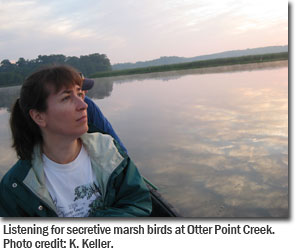 CBNERR-MD monitors the status of secretive marsh birds in both the tidal freshwater and brackish marshes within the Reserve through a volunteer based monitoring program. Secretive marsh birds such as clapper rail, Virginia rail, king rail, least bittern, American bittern, and common moorhen often serve as an indicator species to assess the overall health of wetland ecosystems. Federal agencies are working together to monitor and estimate secretive marsh bird population trends in protected areas across North America in order to document effects of management actions. Several National Estuarine Research Reserve sites around the country, including CBNERR-MD, participate in this effort.
CBNERR-MD monitors the status of secretive marsh birds in both the tidal freshwater and brackish marshes within the Reserve through a volunteer based monitoring program. Secretive marsh birds such as clapper rail, Virginia rail, king rail, least bittern, American bittern, and common moorhen often serve as an indicator species to assess the overall health of wetland ecosystems. Federal agencies are working together to monitor and estimate secretive marsh bird population trends in protected areas across North America in order to document effects of management actions. Several National Estuarine Research Reserve sites around the country, including CBNERR-MD, participate in this effort.
As a participant of the National Marsh Bird Monitoring Program, CBNERR-MD utilizes the North American Secretive Marsh Bird Monitoring Protocol to conduct surveys. Details on the National Marsh Bird Monitoring Program can be found at:
http://ag.arizona.edu/research/azfwru/NationalMarshBird/
The main objectives of this program are to:
- Estimate the density, distribution, and population trends of marsh birds within the Reserve.
- Document habitat conditions that influence abundance of marsh birds.
- Evaluate management actions affecting secretive marsh birds.
 Secretive marsh birds are currently monitored at all three components of the Reserve. Jug Bay surveys began in 2007, where 12 sites are monitored three to four times a year from May to July. Otter Point Creek began monitoring in 2008; with 6 sites surveyed four times a year from May to July. At Monie Bay, surveys began in 2008, with 8 sites being monitored four times a year from May to July.
Secretive marsh birds are currently monitored at all three components of the Reserve. Jug Bay surveys began in 2007, where 12 sites are monitored three to four times a year from May to July. Otter Point Creek began monitoring in 2008; with 6 sites surveyed four times a year from May to July. At Monie Bay, surveys began in 2008, with 8 sites being monitored four times a year from May to July.
How to Get Involved:
If you are interested in participating with the secretive marsh bird surveys, please contact the CBNERR-MD Stewardship Coordinator, Chris Snow ([email protected]). Birding experience is not required but helpful. Surveys involve waking up early to spend several hours on the water, listening to marsh bird vocalizations, and note-taking. In return, you would have the opportunity to enjoy a beautiful and serene morning on the marsh at Jug Bay, Otter Point Creek or Monie Bay and gain experience conducting bird surveys.
Information collected includes:
Species presence, total number, call type, direction, and approximate distance from survey point. If you are interested in our marsh bird monitoring data please contact Chris Snow ([email protected]).